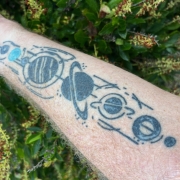A Guide to the Good Life
“A Guide to the Good Life: The Ancient Art of Stoic Joy,” by William B. Irvine.
I’m in Colorado visiting my two granddaughters as I write this. I started reading “A Guide to the Good Life” on the plane. It was one of the few times I wanted the flight to last longer. “Just let me finish one more chapter,” I whispered to the pilot.
This is a book about Stoicism and developing a philosophy of life. Classical Stoicism has little to do with the modern definition of a Stoic: One who is seemingly indifferent to or unaffected by joy, grief, pleasure, or pain.
“I discovered,” writes Irvine, “that the goal of the Stoics was not to banish emotion from life, but rather, to banish negative emotions.” He explains that a “philosophy of life” is the guiding principle for living, or a way of living that hopefully leads to The Good Life.
Irvine explains that The Good Life has little to do with prosperity. Many people have experienced The Good Life despite the lack of prosperity and, of course, think of all the people that are very prosperous and yet are unhappy and miserable.
I’ll be sharing several Stoic Techniques and ways of living as I digest them. They “hit a nerve” with me and I hope they will with you as well.
Stoic Technique One: Negative Visualization
At the very root of our nature is the notion that we are insatiable. We are never satisfied with what we have. Irvine describes this as the “Satisfaction Treadmill.” We desire something and acquire it. We lose interest in it. We desire something else, and so on. This is also called “Hedonic Adaptation.”
We have all witnessed this in our lives. The new car. The new computer. Fill in the blank. The result is that we experience a lack of happiness with the things in our lives, the people in our lives, our health, our job, and life itself.
One technique for getting off of this treadmill is Negative Visualization.
“This is,” Irvine writes, “the single most valuable technique in the Stoic psychological tool kit.” This technique involves periodically visualizing the possibility that the enjoyment of the people and things in your life will come to an end.
-Regarding our children, when we kiss them as they leave for school, remember that they are mortal and not something that we own. They have been given to us but possibly gone tomorrow.
-Regarding a job, visualize losing it due to no fault of your own.
-Regarding your health, reflecting on what it would mean to lose it due to an accident or illness.
-Regarding your spouse or partner, think about losing them to death or to divorce.
This is not intended to be morbid or for the purpose of robbing you of the joy that these people, activities or things bring to your life.
Rather it is intended to:
-Help you cherish every kiss from your spouse, your partner, or your child.
-Help you appreciate getting up and going to your job each day.
-Get you out and enjoy the health you do have rather than the health problems you have.
-Embrace the life that you have each day.
-Learn to desire the people and things that you already have.
Irvine concludes, “Negative Visualization, rather than making people glum, will increase the extent to which they enjoy the world around them, in as much at it will prevent them from taking that world for granted.”
There is something sobering about thinking that all things and people in our lives are temporary and impermanent. It is sobering to visualize that the life we have will come to an end and that we will eventually lose everything.
This Stoic technique helps us to take live one day at a time and treat the people in our lives as precious and priceless.
I think this is a worthy Philosophy of Life that will help lead us to The Good Life.
I’ll be sharing additional Stoic Techniques in upcoming Blogs. Stay tuned.












